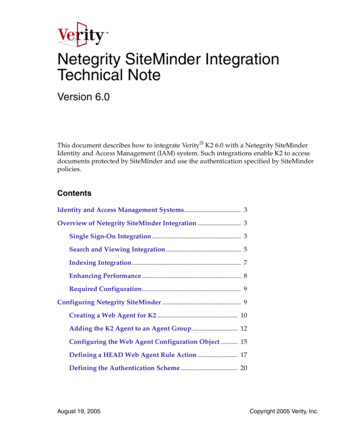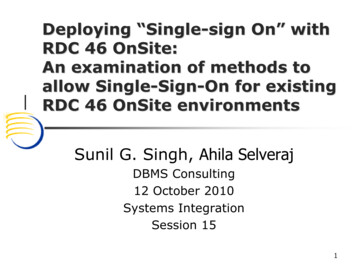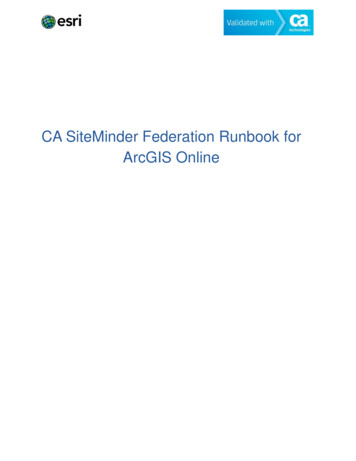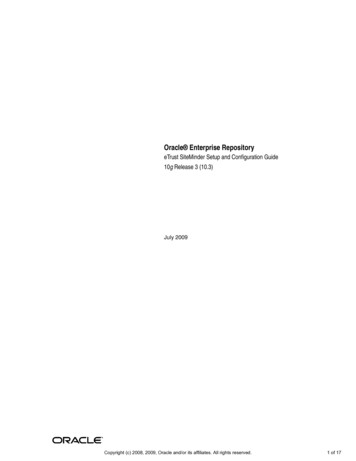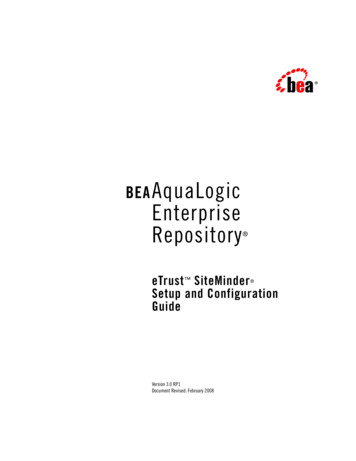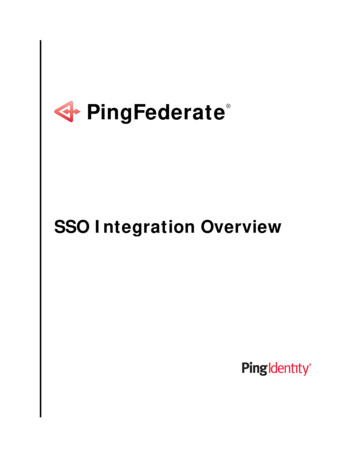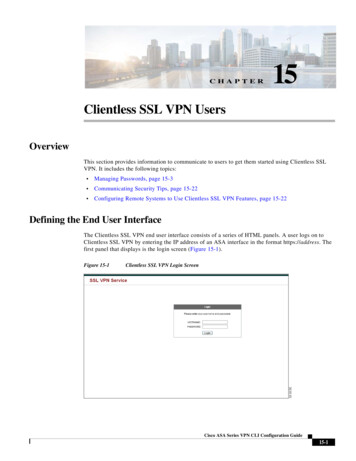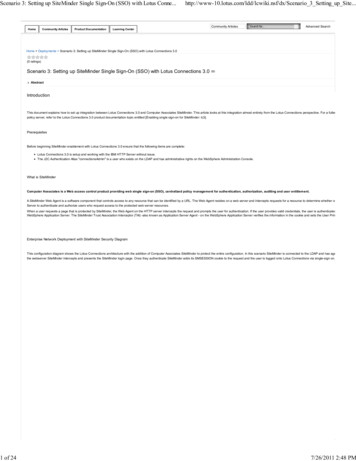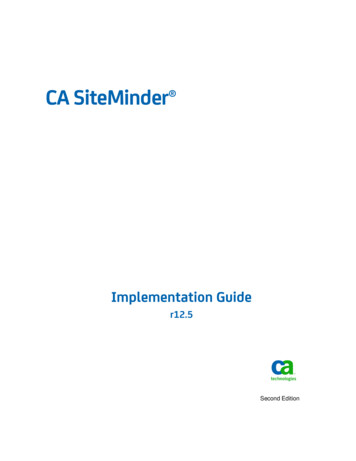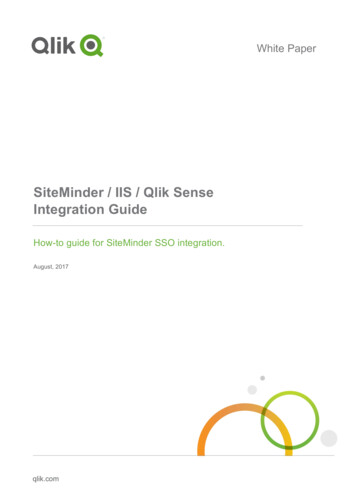
Transcription
White PaperSiteMinder / IIS / Qlik SenseIntegration GuideHow-to guide for SiteMinder SSO integration.August, 2017qlik.com
Table of ContentsOverview3Requirements3Setup3Virtual Proxy3SiteMinder Policy Server5SiteMinder Web Agent5Test7Appendix8Internet Information Services 8.58Using Apache as a Reverse Proxy for Authentication with Qlik SenseReferences1015SiteMinder / IIS / Qlik Sense Integration Guide 2
OverviewThere are three main services that need to be configured for thisintegration, sections 2-5 will go over these and the three services are asfollowed: Qlik sense Internet Information Server SiteMinder Policy Server / Web AgentRequirementsThese are the conditions and special features that must be installed:Choice of Web ServersThis guide provides setupinstructions using IIS 8.5 in theAppendix, as well as how to set upa reverse proxy for Qlik Sense withApache. There is a note in theApache guide on what you willneed to add for it to work withSiteMinder, but ultimately anyreverse proxy will do. That said,WebSockets must be supported. Qlik Sense environment installed, licensed and ready to use SiteMinder Web Agent must be installedRefer to the Appendix for webserver setup guides. SiteMinder Policy Server must be configured Internet Information Services version 8.5 (with WebSocket protocolsupport) ARR toolkit must be installed for IIS (incl. UrlRewrite module)SetupVirtual ProxyCreate a new virtual proxy for your SiteMinder authentication. You will want to use the “static headerauthentication” module, with the header being “SMUNIVERSAL ID”. Note that the header can be any valueyou would like, but it MUST match the header on the SiteMinder policy server. The following shoes threevirtual proxies for the regions: AMERICAS, EMEA, APAC.Important – “Session cookie header” name(s) must be:SiteMinder / IIS / Qlik Sense Integration Guide 3
In order for Qlik Sense to be accessed, the “Websocket origin white list” must be properly maintained. Here wehave the the local IP (public network card) and the computer’s FQDN.You must then link the virtual proxy to the default proxy. If the link (Association) is not made, users willreceive a 404 error in the hub when attempting to connect via the virtual proxy (example: the EMEAregion for access).If IIS and Qlik Sense are running on the same server, you will need to change the default port values. Theexample here shows: Running IIS on port 443 Qlik Sense proxy port 80 is changed to 8080 Qlik Sense proxy port 443 is changed to 1443Note: After this change, you will need to use port 1443 to access the QMC!You will also need to make sure you have licensed your Qlik Sense environment to give users access. Here weare giving users “User access allocations” so they can get access to the Hub. Important – Unlicensed accessto the Qlik Sense Hub is not possible (different to the QlikView AccessPoint, which could be openedwithout a license)SiteMinder / IIS / Qlik Sense Integration Guide 4
SiteMinder Policy ServerThe authentication header "SMUNIVERSAL ID" must be sent in all requests that go to the Qlik Senseproxy (port 1443). SiteMinder is configured in that the default settings specify that no headers will besent with specific file extensions (such as .js, .css, .png etc). These defaults are not sufficient forQlik Sense when using the authentication header. The solution is to configure the “IgnoreExt”parameter on the policy server (not local Web Agent), so it allows extensions with headers. “IgnoreExt” is the keyword. This is a parameter is used to specify that URLs with a specificextension should be ignored. By default, this flag is turned off, so that SiteMinder authenticationchecks all URLs. The parameter is used only for the WebAgent, so no change are required forthe AppServer.SiteMinder Web AgentInstall SiteMinder Web AgentCheck that the correct “hostconfigobject” is used:SiteMinder / IIS / Qlik Sense Integration Guide 5
The following configuration files must be available:SiteMinder / IIS / Qlik Sense Integration Guide 6
TestAccess the DNS name qliksense-test.e.corpintra.net/emea, or one of the following as defined in the virtual proxystep in the document: /emea for users in EMEA /americas for users from AMERICA /apac for users in APACSiteMinder / IIS / Qlik Sense Integration Guide 7
AppendixInternet Information Services 8.5SiteMinder Web Agent must be integrated via ISAPI filterDefault Web Site configuration: Port binding of 443 with certificate and active anonymous authenticationSiteMinder / IIS / Qlik Sense Integration Guide 8
URL Rewrite module must be configured with a reverse proxy (forwarding on DNS name and port 8080)SiteMinder / IIS / Qlik Sense Integration Guide 9
Using Apache as a Reverse Proxy for Authentication with Qlik SenseA common scenario that we have used with great success in QlikView is the use of a reverse proxyfor authenticating the user. In these scenarios we use what we call header authentication whichmeans that you add a HTTP header to the requests going to Qlik servers that it will trust and use asthe user.Important to maintain the security of this setup is that all traffic going to Qlik Sense need to go throughthe reverse proxy.In Qlik Sense this architecture is not as common mainly based on the limited support for websocketsin reverse proxies. But now there is a couple that you can use NGINX (Reverse Proxy with QlikSense, NGINX as reverse proxy with Qlik Sense), IIS with Application Routing Request (IIS asReverse Proxy for Qlik Sense) and Apache.In this blog post I will try to explain one configuration that can be used to enable header authenticationwith Apache Reverse Proxy.For this to work we need to build it on a Apache version that supports websockets (mod wstunnel), soI recommend using a version after 2.4.10 as earlier versions even though they support websocketshas buggy implementations.So what configuration do we need to do?In this example I will use two configuration files the httpd.conf which is the main configuration file forApache and then httpd-vhosts.conf which is a config file for a virtual host but included in the httpd.confThe first thing we need to do is to make sure the httpd.conf listen to the right port, in this example9090Listen 9090SiteMinder / IIS / Qlik Sense Integration Guide 10
We also have to make sure that the httpd.conf load the needed dModuleproxy module libexec/apache2/mod proxy.sorewrite module libexec/apache2/mod rewrite.soproxy wstunnel module libexec/apache2/mod proxy wstunnel.soproxy http module libexec/apache2/mod proxy http.soauthn file module libexec/apache2/mod authn file.somod auth file is only needed for this example and in most cases this module should be replaced by amod for the type of authentication the customer require.We also have to make sure the httpd-vhosts.conf is loaded in the httpd.conf# Virtual hostsInclude /private/etc/apache2/extra/httpd-vhosts.confNow when we are ready with the httpd.conf we can do the configuration of the httpd-vhosts.conf Note that you will want to add your SiteMinder Header (example: “SMUNIVERSAL ID”) in thisconfig file.# Virtual Hosts## Required modules: mod log config# If you want to maintain multiple domains/hostnames on your# machine you can setup VirtualHost containers for them. Most configurations# use only name-based virtual hosts so the server doesn't need to worry about# IP addresses. This is indicated by the asterisks in the directives below.## Please see the documentation at# URL:http://httpd.apache.org/docs/2.4/vhosts/ # for further details before you try to setup virtual hosts.## You may use the command line option '-S' to verify your virtual host# configuration.## Qlik Sense Reverse Proxy configuration for header authentication## Qlik Sense configuration needed:# - Create a new virtual proxy with header authentication static user directory (use#QVUSER as header name)# - Add reverse proxy name and IP address to whitelist of virtual proxy#Put IP address of reverse proxy as LOCAL ADDR#Put IP address of Qlik Sense server as REMOTE ADDR#Put your vitrual proxy prefix as VIRTUAL PROXY#Put name of the HTTP header with the user name in USER HEADER FIELDDefine LOCAL ADDR 10.88.148.228Define REMOTE ADDR 10.76.137.17Define VIRTUAL PROXY headerDefine USER HEADER FIELD QVUSERSiteMinder / IIS / Qlik Sense Integration Guide 11
VirtualHost *:9090 ServerAdmin name@qlik.comDocumentRoot "/Library/WebServer/Documents"ServerName {LOCAL ADDR}:9090ServerAlias reverse-proxy.rdlund.qliktech.com# ErrorLog m-error.log"# CustomLog m-access.log" commonProxyRequests OffProxyPreserveHost OnKeepAlive OnRewriteEngine On#Add header to all requests with the user.RewriteRule .* - [E PROXY USER:%{LA-U:REMOTE USER}]RequestHeader set {USER HEADER FIELD} %{PROXY USER}e# If it is a websocket request forward as websocket trafficRewriteCond %{HTTP:UPGRADE} WebSocket [NC]RewriteCond %{HTTP:CONNECTION} Upgrade [NC]RewriteRule .* ws:// {REMOTE ADDR}%{REQUEST URI} [P] Proxy * Order deny,allowAllow from all /Proxy #Protect location with appropriate authentication Location / {VIRTUAL PROXY} ProxyPass http:// {REMOTE ADDR}/ {VIRTUAL PROXY} connectiontimeout 5timeout 300ProxyPassReverse http:// {REMOTE ADDR}/ {VIRTUAL PROXY}AuthType basicAuthName "private area"Requirevalid-userAuthBasicProvider fileAuthUserFile /etc/apache2/extra/users /Location /VirtualHost There are a couple of important parts in this configuration file#Add header to all requests with the user.RewriteRule .* - [E PROXY USER:%{LA-U:REMOTE USER}]RequestHeader set {USER HEADER FIELD} %{PROXY USER}eWhen a user is logged in to apache the user name is stored in the environment variableREMOTE USER. With this rule we copy this user to a variable and then add the HTTP headerQVUSER to all requests with the value of the user id of the logged in user.# If it is a websocket request forward as websocket trafficRewriteCond %{HTTP:UPGRADE} WebSocket [NC]RewriteCond %{HTTP:CONNECTION} Upgrade [NC]RewriteRule .* ws:// {REMOTE ADDR}%{REQUEST URI} [P]SiteMinder / IIS / Qlik Sense Integration Guide 12
The second rule looks in the HTTP headers of requests coming in, if it contains the headers of awebsocket upgrade we will forward this as websocket to the Qlik Sense server.#Protect location with appropriate authentication Location / {VIRTUAL PROXY} ProxyPass http:// {REMOTE ADDR}/ {VIRTUAL PROXY} connectiontimeout 5timeout 300ProxyPassReverse http:// {REMOTE ADDR}/ {VIRTUAL PROXY}AuthType basicAuthName "private area"Requirevalid-userAuthBasicProvider fileAuthUserFile /etc/apache2/extra/users /Location Then we add a default location and protect it using authentication. In this example I've used the buildin mod auth file module for authentication but this should be replaced by what is needed by thecustomer (SAML, OAuth, LDAP.)With this configuration, we now have setup Apache to be able to act as a reverse proxy for QlikSense. Next step is to configure Qlik SenseQlik Sense configurationThe configuration in Qlik Sense consists of adding a Virtual Proxy, configure it for headerauthentication and adding the Reverse Proxy IP/DNS name to the whitelist.Below are screenshots of the configuration of the header authentication neededHere we have configured a Virtual proxy for header authentication. In this case we don't use a prefixbut that could be used if needed. We changed the name of the cookie and selected "Headerauthentication static user directory" as the Authentication method. We added the header name asQVUSER and configured that the users coming in would belong to the UD named ABC.Then we also add the IP address of the reverse proxy to the whitelist. In most configurations weshould also add the DNS name of the reverse proxy.SiteMinder / IIS / Qlik Sense Integration Guide 13
With this configuration we are now ready to use the reverse proxy and authenticate to Qlik Sense bywriting http://[Reverse proxy]:9090/hub in the browserThe configuration of the examples can be found verseProxySiteMinder / IIS / Qlik Sense Integration Guide 14
ReferencesLautrup, F. (2016, Sep. 21). Using Apache as a Reverse Proxy for Authentication with Qlik Sense.Nünning, F. (2016, Mar. 10). Daimler - Qlik Sense / SiteMinder Integration.SiteMinder / IIS / Qlik Sense Integration Guide 15
150 N. Radnor Chester RoadSuite E120Radnor, PA 19087Phone: 1 (888) 828-9768Fax: 1 (610) 975-5987qlik.com 2017 QlikTech International AB. All rights reserved. Qlik , Qlik Sense , QlikView , QlikTech , Qlik Cloud , Qlik DataMarket , Qlik AnalyticsPlatform , Qlik NPrinting , Qlik Connectors , Qlik GeoAnalytics and the QlikTech logos are trademarks of QlikTech International AB which havebeen registered in multiple countries. Other marks and logos mentioned herein are trademarks or registered trademarks of their respective owners.SiteMinder / IIS / Qlik Sense Integration Guide 16
SiteMinder / IIS / Qlik Sense Integration Guide 5 SiteMinder Policy Server The authentication header "SMUNIVERSAL_ID" must be sent in all requests that go to the Qlik Sense proxy (port 1443). SiteMinder is configured in that the default settings specify that no headers will be sent with specific file extensions (such as .js, .css, .png etc).
